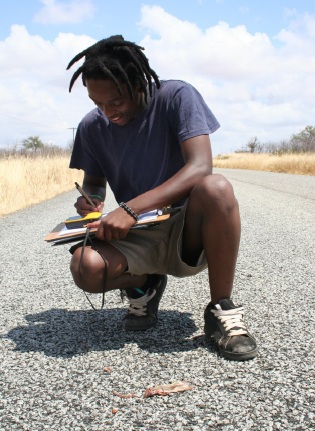The last week of the roadkill project has shown a real diversity of species being hit on the roads. Although not as many per kilometre as the study in March (due to possible seasonal differences), the figures are still high, with almost 30 roadkills in 3 days.
I was joined the other day by two volunteers (Silvia Vanzulli and Katlego Makutulela) who wanted to see what the study was all about.
Silvia is from Italy and staying in South Africa for 6 weeks. She is a volunteer with Galagos Wildlife Conservation (GWC), an organisation based on the De Beers Venetia Limpopo Nature Reserve that assists the reserve management with the day-to-day running of the nature reserve. Additionally, they are keen to assist on current research projects conducted in the area.
Kat is in his second year of his Game Ranch Management Diploma course at Tshwane University of Technology in Pretoria. He said that he had no idea that roadkill was a part of conservation, and after the day he spent with me, I think I now have a convert!
They joined me for the morning transect, having warned them not to expect too much. Within 3 kms, we had our first casualty; a scrub hare. I showed them how I wanted the data collecting and then said that they would be doing it for the rest of the transect. Again, Kat was surprised at the amount of detail needed, ‘he thought he was just going to be counting dead bodies.’ Sylvia and Kat had to assess the surrounding habitat, grass height and thickness and fence type, all based on an index I have devised. It took about 15 minutes for them to record all of the data.
Moving on, we found a number of different species. If there was any positive outcome in the number of roadkill we found, it was that it enabled both of them to practise identifying different species. (It’s often hard to identify a bird, for example, when it’s in flight.) In this case, they could study the animal up close (only the ones that weren’t too squashed). Sylvia was particularly fascinated with a Mozambique Spitting Cobra. I doubt many people have had the opportunity to handle one of these due to it being extremely venomous and bites often being fatal. We were able to look closely and touch the scales which were smooth. The Mozambique Spitting Cobra has a section of beautiful black cross band markings on its throat, which makes it so distinctive, which again we were able to examine closely. Additionally, the adult Mozambique Spitting Cobra can grow to over two metres in length, and mainly forages at night. This ‘baby’ was about 1 metre in length, and suggests that it was ‘only’ a juvenile. Since it was so recently hit by a car, we can assume that it was a juvenile as juveniles are generally active during the day when they hunt for small reptiles and rodents.
I was surprised at the number of snakes that we were finding on the road. Snakes often come onto the roads to bask on the warm road surface. It isn’t quite warm enough yet, but clearly the number of snakes appearing suggests that the hot temperatures associated with this area are on their way. I hope not too many though ………

Thanks again to Duncan MacFadyen, Ian Little, Jeanne Tarrant, Dan Parker and Michael Cunningham for assistance with identification.



